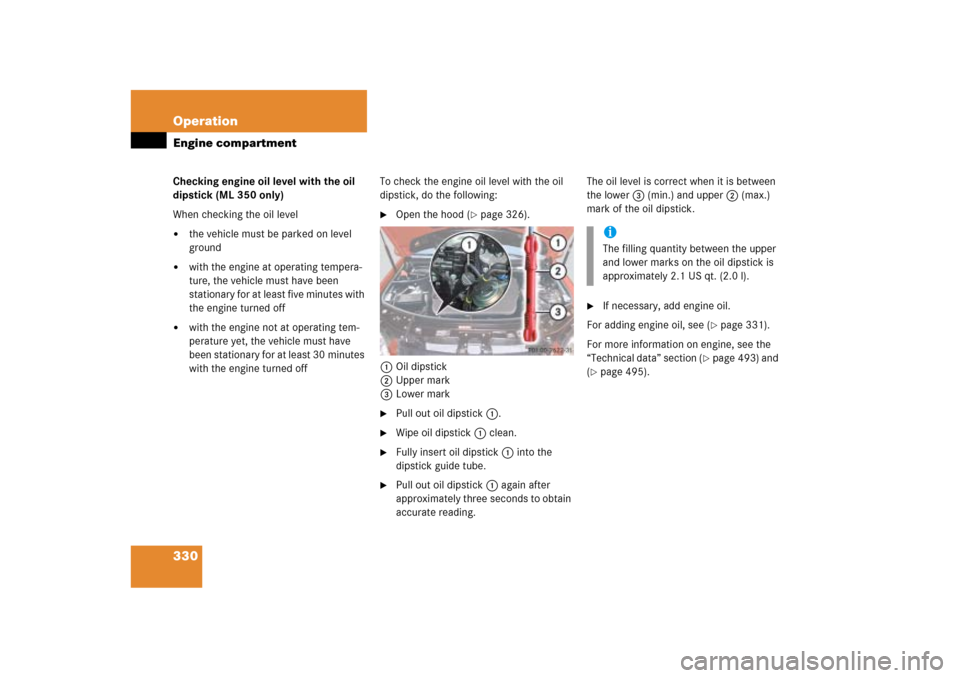Page 308 of 539

307 Operation
Driving instructions
Off-road driving rules�
Engage the Off-road driving program
(�page 248) before driving under
off-road conditions.
�
If equipped with vehicle level control*,
make sure you select a vehicle level ap-
propriate to the topographical condi-
tions. Always make sure the vehicle
has enough ground clearance.
�
Fasten items being carried as securely
as possible (
�page 259).
�
Always navigate gradients with the en-
gine on and with the transmission en-
gaged in a gear. Switch on the DSR
(�page 245) to help maintain a preset
speed.Checklist before off-road driving
Engine oil level
�
Check the engine oil level with the
control system (ML 500 only)
(�page 328), or with the oil dipstick
(ML 350 only) (
�page 330).
Only with a proper oil level can the
vehicle obtain a trouble-free oil supply,
even on steep gradients.
iWe recommend keeping doors, tail-
gate, windows, and tilt/sliding sun-
roof* closed whenever driving in
off-road mode.
!Observe the following during off-road
driving:�
Adjust vehicle speed to condition of
terrain. The more uneven, rutty and
steeper the terrain, the lower the
speed should be.
�
Watch out for obstacles, such as
rocks, holes, tree stumps and ruts.
�
Be especially careful when driving
in unknown territory. It may be nec-
essary to get out of the vehicle and
scout the path you intend to take.
�
Before driving through water, deter-
mine its depth.
�
Do not stop vehicle while immersed
in water, and do not shut off the
engine.
�
In sandy soil, please drive at a
steady speed as allowed by condi-
tions. This helps overcome the vehi-
cle rolling resistance and reduces
the likelihood of the vehicle sinking
into the ground.
�
Do not initiate jumps with the vehi-
cle. It interrupts the forward mo-
mentum of the vehicle.
�
Always drive onto slopes with the
engine running and the vehicle in
gear.
Page 331 of 539

330 OperationEngine compartmentChecking engine oil level with the oil
dipstick (ML 350 only)
When checking the oil level�
the vehicle must be parked on level
ground
�
with the engine at operating tempera-
ture, the vehicle must have been
stationary for at least five minutes with
the engine turned off
�
with the engine not at operating tem-
perature yet, the vehicle must have
been stationary for at least 30 minutes
with the engine turned offTo check the engine oil level with the oil
dipstick, do the following:
�
Open the hood (
�page 326).
1Oil dipstick
2Upper mark
3Lower mark
�
Pull out oil dipstick1.
�
Wipe oil dipstick1 clean.
�
Fully insert oil dipstick1 into the
dipstick guide tube.
�
Pull out oil dipstick1 again after
approximately three seconds to obtain
accurate reading.The oil level is correct when it is between
the lower3 (min.) and upper2 (max.)
mark of the oil dipstick.
�
If necessary, add engine oil.
For adding engine oil, see (
�page 331).
For more information on engine, see the
“Technical data” section (
�page 493) and
(
�page 495).iThe filling quantity between the upper
and lower marks on the oil dipstick is
approximately 2.1 US qt. (2.0 l).
Page 512 of 539

511 Index
Checking
Coolant level 332
Engine oil with the
control system (ML 500 only) 328
Engine oil with the
oil dipstick (ML 350 only) 330
Oil level 327
Tire inflate pressure 325
Vehicle lighting 325
Checking tire pressure
electronically with the
Advanced Tire Pressure Monitoring
System* (Advanced TPMS*) 351
Checking weights
Trailer and vehicle 315
Checklist
Off-road driving 307
Returning from off-road driving 313
Child safety 78
Air bags 68
Infant and child
restraint systems 73, 78
LATCH type child seat mounts 88Child safety switch see Blocking of rear
door window operation
Cigarette lighter*
Front center console 275
Cleaning
Carpet 379
Cup holder 379
Gear selector lever 379
Hard plastic trim items 379
Headlamps 194
Headliner 379
Instrument cluster 379
Leather upholstery* 380
Light alloy wheels 379
MB Tex upholstery 380
Plastic and rubber parts 380
Seat belts 379
Steering wheel 379
Windows 378
Windshield 56
Wiper blades 378
Cleaning and care of the vehicle 374
Cleaning tires 337Climate control 202
Adjusting 207
Adjusting air volume 208
deactivating 206
Defrosting 208
Rear passenger compartment 213
Rear window defroster 200
Setting the temperature 207
Clock 165
Closing
Glove box 270
Hood 327
Power tilt/sliding sunroof* 439
Side windows 231
Side windows with
KEYLESS-GO* 234
Tailgate 120
Vehicle with KEYLESS-GO* 123,
124
Tilt/sliding sunroof* 235
Tilt/sliding sunroof* with
KEYLESS-GO* 234
Windows 230
Page 516 of 539

515 Index
Emergency operations
Closing tilt/sliding sunroof* 439
Locking the vehicle 436
Opening tilt/sliding sunroof* 439
Remote door unlock 288
Unlocking the vehicle 435
Emergency tensioning device see ETD
Emission control 321
Ending
A call (telephone*) 180
Engine
Message in the display 410
Starting 49
Starting with KEYLESS-GO* 50
Technical data 486
Turning off 62
Engine cleaning 376
Engine compartment
Hood 326
Main fuse box 478
Engine malfunction
indicator lamp 385, 410
Engine malfunction indicator
lamp (Canada only) 25
Engine malfunction indicator
lamp (USA only) 25Engine number 502
Engine oil 327, 495
Adding 331
Additives 495
Checking level 327
Checking with the
control system (ML 500 only) 328
Checking with the
oil dipstick (ML 350 only) 330
Consumption 327
Display messages 414–415
Messages in display 329, 414–415
Viscosity 502
ESP
®
25, 95, 502
Off-road-ESP
®
98
Switching off 97
Switching on 98
Warning lamp 387
ETD 502
Safety guidelines 70
ETD (Emergency tensioning device) 76
Exterior mirrors
Folding 197
Exterior rear view mirrors
Adjusting 44
Parking position* for 174F
Fastening the seat belts 46
First aid kit 430
Flat tire 456
Lowering the vehicle 460
Preparing the vehicle 457
Spare wheel 433
Flexible Service System PLUS
(FSS PLUS) 502
Floormats* 279
Fluid level
Automatic transmission 332
Fog lamp, rear
Switching on 142
Fog lamps
Replacing bulbs 443
Fog lamps, front
Messages in display 418
Replacing bulbs 445
Switching on 142
Folding
Exterior mirrors 197
Folding the backrest forward 261
4-ETS 98
Off-road - 4-ETS 99
Page 523 of 539

522 IndexN
Navigation system see separate Modular
COMAND System operating instructions
Night security illumination 141
Normal occupant weight 366
O
Occupant Classification System 81
Self-test 86
Occupant Classification System see OCS
Occupant distribution 366
Occupant safety 66
Children and air bags 68
Children in the vehicle 78
Fastening the seat belt 46
Infant and child restraint systems 78
LATCH type child seat mounts 88
Seat belts 46, 70
OCS 504
Off-road - 4-ETS 99
Off-road - ABS 94
Off-road - ESP
®
98Off-road driving
Checklist 307, 313
Crossing obstacles 311
Driving instructions off-road
driving 306
Driving through water 310
Returning 313
Rules 307
Special driving features 306
Steep terrain 308
Off-road driving program 248
Switching off 249
Switching on 249
Oil
Adding 331
Consumption 327
Dipstick 327
Filler neck 331
Viscosity 502
One-touch gearshifting
Canceling gear range limit 190Opening
Doors from the inside 117
Fuel filler flap 323
Fuel filler flap manually 438
Glove box 270
Hood 326
Power tilt/sliding sunroof* 439
Side windows 232
Tailgate 118
Tilt/sliding sunroof* 235
Tilt/Sliding sunroof* in an
emergency 439
Windows 230
Opening the tailgate from
the inside electrically* 118
Opening the tailgate from
the outside 118